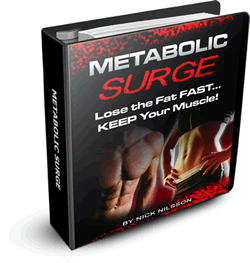By Nick Nilsson
Author of Metabolic Surge - Rapid Fat Loss
To really fire up your fat-burning furnace, you need a workout that addresses not only calories burned DURING the workout itself, but also calories burned AFTER the workout.
But it doesn't end there...to REALLY maximize your results, you need to also address your body's HORMONAL response to training.
When you put all these factors together, you can SERIOUSLY increase the fat-burning drive you generate with each and every workout.
Let's look at the factors one at a time...
1. Calories burned DURING the workout
Every time you exercise, you burn calories. Makes sense! The amount of calories you burn depends on the specific exercise you're doing, how intense it is and how long you do it for. I won't spend much time on this one as pretty much everybody knows instinctively that the harder and longer you work, the more calories you burn.
2. Calories burned AFTER the workout
Here's where it gets interesting...the more intense the exercise you perform, the more your overall metabolism is boosted and the more calories your body will burn AFTER the workout as it strives to recover from the training.
The practical result is this...if you do long, slow cardio training for your fat loss, you will burn calories during the workout, but your metabolism will go back to its normal rate very soon after. If you increase the pace (e.g. through interval training), you create a MUCH greater demand on your body and your metabolism is jacked up long after your workout is done - this can be for up to 24 hours after!
When it comes to fat loss, intensity is the key, not your resistance to boredom during repetitive movement.
3. Your HORMONAL response to training
Here's the one most people don't know about. When you exercise, whether it be for fat loss or any other purpose, your body secretes hormones in response to the training. The big one that we want to key in on for fat loss is Growth Hormone.
Without delving too much into the science of Growth Hormone (GH for short), it's enough to know that one of the primary functions of GH is to send a signal to your body to burn fat for fuel (it's also involved in many other functions, including muscle building, immune system function and connective tissue repair).
So how do we maximize the release of natural GH in the body from training? Lactic Acid.
Lactic Acid is one of the key "ingredients" that we want the body to produce in order to maximize the release of GH. When the body detects large amounts of Lactic Acid in the blood stream (it determines this by tracking the acidity of your blood), GH is secreted in response.
The greater the burn, the greater the GH release.
How do we maximize ALL THREE aspects of fat loss that I mentioned above? We will do it through a training technique I call "No-Rest Lactic Acid Supersetting."
We are going to combine several techniques that are extremely effective for maximizing the production of Lactic Acid in the body. I'll tell you up front, this training WON'T be easy (if you find it easy, you're not working hard enough!) but it's VERY effective.
The first part of the equation is high-rep training. There is NO doubt that high reps will produce Lactic Acid. The bonus with high-rep training is that it also helps improve the capillarization of the muscles.
In English, this means it helps improve the blood supply to the muscles by increasing the amount of tiny blood vessels (capillaries) in the muscles. One of the reasons muscles don't grow? Poor blood supply. So high-reps can not only produce Lactic Acid, they can even improve the growth potential of a muscle!
The next part of the equation is Supersetting. Supersets involve moving from one exercise directly into another exercise, with no rest in between the two exercises. This is a great way to increase the burn from Lactic Acid. The specific type of Supersets we'll be using with this training technique are "Antagonistic Supersets." This means we'll be working two opposing bodyparts at a time, e.g. back and chest or biceps and triceps.
The final part of the equation is that we're not only NOT going to take any rest between the two Superset exercises, we're actually not going to take ANY REST AT ALL (except when we move to a different Superset combination).
The body clears out Lactic Acid when it gets a chance to rest. By removing complete rest from the equation, we're going to dramatically ramp up the production of Lactic Acid in your body and, as a result, ideally dramatically ramp up the production of Growth Hormone in response.
All this, in turn, will lead to increased fat loss by increasing Growth Hormone and burning LOTS of calories during the workout AND after the workout, because of the high intensity level.
A quick note about Growth Hormone: there are plenty of websites and magazines that will try to sell you HGH pills to increase your GH levels. While some nutritional supplements can be moderately effective at boosting GH levels (glutamine is one), the vast majority of these HGH ads are scams and should be avoided. Your body, with proper training, can produce ample amounts on its own.
How To Do No-Rest Lactic Acid Supersetting:
I will use chest and back as the example bodyparts for this training program. We will be switching between dumbbell presses on the ball and standing dumbbell rows (using two dumbbells in bent-over row position). I find this to be a good combination because you can use the same dumbbells for both exercises and perform them in the very same spot.
The key with this training technique is speed...during the sets and switching between exercises.
First, select a pair of dumbbells that you know you can get at least 20 reps with on the dumbbell press. For this technique, 20 reps is going to be the MINIMUM number of reps we want to hit on the first set of dumbbell presses.
Get into position on the ball and begin pressing the dumbbells. Keep a fairly quick tempo on the presses using a powerful movement, not worrying about squeezing the muscles or getting any slow negatives (the lowering phase of the movement). It should be a fast, powerful movement to get as many reps as you can.
Big note here...DO NOT sacrifice form for speed. If you're flailing the dumbbells around, you're going to hurt yourself. While the movement is fast, it should be UNDER CONTROL at all times.
Do as many reps as you can until the Lactic Acid burn forces you to stop. The last reps will see you moving a LOT slower than you started but keep going until the burn stops you.
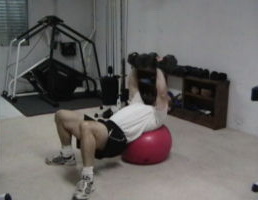
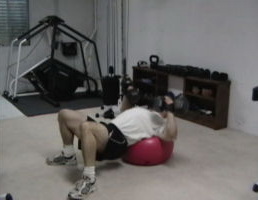
Now set the dumbbells down and IMMEDIATELY get into position for the two dumbbell rows. The two dumbbell row is performed exactly like a bent-over barbell but using two dumbbells instead (the link will also include demo pictures on how to perform both of these exercises).
Begin rowing with the same quick tempo. Be VERY careful that you're not bobbing up and down excessively as you do this exercise. It's fine to have a little movement - it's natural as the weight comes up and down. But you should do your best to keep your lower back arched, your abs tight and your torso as still as possible.
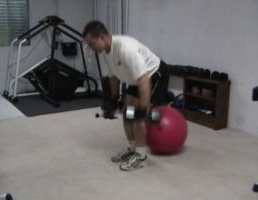
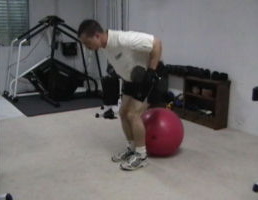
Again, perform as many reps as you can until the burn stops you and you have to set the weights down.
Now IMMEDIATELY put all thoughts of rest aside. Grab those dumbbells, get back on the ball and starting cranking out more dumbbell presses.
Your reps will most likely drop fairly significantly on this second round through due to muscle fatigue and Lactic Acid accumulation. Get as many reps as you can, though. Personally, I may start my first set with 30 to 40 reps and get 8 to 10 on the second set.
Finish the pressing reps then go right back to the dumbbell rows for as many reps as you can. Keep going back and forth between exercises until you've done the prescribed number of sets for each bodypart (see below for recommendations).
Be sure to push yourself on those sets. Make sure you stop because of the Lactic Acid burn and not because you've counted enough reps and you've lost track.
I've demonstrated the first two and a half sets of this technique - 1 bench press on the ball, 1 dumbbell row then back to the first few reps of bench press on the ball on the next set. When you're actually performing the technique, keep going in the back-and-forth fashion until you've done all your sets. No rest in between.
Also, in order to keep time down, I didn't push to complete Lactic Acid-induced failure on these sets. When you do your sets, the last few reps should be a slow grind, fighting the burn to complete the reps.
As for number of sets, here are my recommendations...
If you're going to do your entire body in one workout use the following set guidelines:
Back and chest - 6 sets each
Quadriceps and Hamstrings - 6 sets each
Shoulders and Calves - 3 sets each
Biceps and Triceps - 3 sets each
The reason shoulders and calves are paired together is that neither muscle group really has an antagonist to it.
If you're going to split up your workouts, I would suggest picking two of the combinations (whichever combos you like to do together) and use the following set guidelines:
Back and chest - 8 sets each
Quadriceps and Hamstrings - 10 sets each
Shoulders and Calves - 5 sets each
Biceps and Triceps - 5 sets each
This means if you want to do back, chest, biceps, triceps, do 8 sets each of back and chest then 5 sets each of biceps and triceps.
Take 1 minute rest in between bodypart combinations or judge it by the time it takes for you to set up the next two exercises.
Perform this training program three times a week, e.g. Monday, Wednesday, Friday if you're doing total body workouts. If you're splitting your body up, do Monday, Tuesday, Thursday, Friday.
Follow this training technique for 3 weeks and then check the mirror.
A small note about Growth Hormone:
DO NOT eat anything before training when you're doing this program. It's best to perform this training on an empty stomach. The reason for this is that GH secretion is reduced by both elevated blood sugar levels and/or elevated insulin levels in the body. When you eat something (specifically carbohydrates), your blood sugar will rise and insulin will be secreted as a result. Insulin is a storage hormone and works directly against GH.
AFTER training, it's a whole different ballgame. You CAN take in carbs and it won't affect the post-workout fat-burning process. Because of the tremendous demands on the recovery systems from a hard workout, your body will continue to use stored fat to fuel the recovery process even when you take in carbs.
So be sure to take in some good post-workout nutrition in the form of liquid protein and carbs. It'll help speed recovery and keep your body from eating up its own muscle tissue.
Conclusion:
If you're looking for a shock to your body to kick-start your fat loss, give this workout a try. It'll place tremendous demands on your body and put your fat loss into high gear.
![]()
More From Fitstep.com
Share This Page...
---
Home -> Fat Loss -> Workouts -> No-Rest Lactic Acid Supersetting



